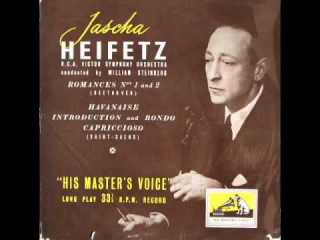Camille Saint-Saens – Havanaise-Introduction et Rondo Capriccioso
Camille Saint-Saens – Havanaise-Introduction et Rondo Capriccioso

Havanaise Op.83 for Violin and Orchestra
1. Allegretto e Lusinghiero
2. Allegro
3. Allegretto non troppo
Introduction et Rondo Capriccioso Op.28 for Violin and Orchestra
1. Andante
2. Allegro non troppo
3. Piu Allegro
Jascha Heifetz – violin
RCA Victor Symphony Orchestra
William Steinberg – conductor
Saint-Saëns completed the Havanaise in E major for violin and orchestra, Op. 83, in 1887; however, the work's origins predate this by two years. In November 1885, the composer set out on a concert tour with the violinist, Raphael Diaz Albertini, playing throughout northern France before moving on to Germany. While in Brest on a cold night, Saint-Saëns built a fire in his hotel room, the popping sound of the burning wood sparking a melodic idea in his mind. Saint-Saëns originally wrote the piece for violin and piano, soon after orchestrating the piano accompaniment. The Havanaise, Op. 83, was published in 1888 in Paris with a dedication to Albertini.
A havanaise (habañera in Spanish) is a dance in 2/4 time that developed in Cuba from African rhythms. Saint-Saëns' Latin-sounding main theme consists of an eighth note triplet on the first beat of the measure and a duplet on the second, creating a Latin rhythm that appealed to Albertini, who had Cuban origins. The drooping melody is punctuated with fiery virtuosic passages and whenever it moves away from the havanaise rhythm and becomes reflective, a soft drum steps in to remind us of the opening dance. After a quick passage, we hear two more themes, these more Romantic in flavor than the main theme. Unlike the first theme, these are entirely the property of the soloist, and the orchestra is reduced to an accompanimental role while continuing to give us the havanaise rhythm. During the developmental, virtuosic passages, Saint-Saëns' inserts quick asides for the violin, as well as the smooth chromatic scales and trills, to suggest glances and caresses. A high, sustained harmonic on the solo violin closes the work.
The Introduction and Rondo capriccioso, Op. 28 (1863), is one of Saint-Saëns' few genuine showpieces. It was composed for his friend, the virtuoso violinist Pablo de Sarasate (1844-1908), for whom he had already written the Violin Concerto in A major, Op. 28 (1859), and for whom he would eventually create the Violin Concerto in B minor, Op. 61 (1880). Whereas the Op. 28 Violin Concerto was written when the violinist was only 15 years of age, the Introduction and Rondo capriccioso is deliberately challenging -- a testimony to the mature master's technique. Sarasate's frequent programming of the work did a great deal for its popularity in the years after its publication (1870); its appeal was wide enough, in fact, that both George Bizet and Claude Debussy made arrangements of it -- the former for violin and piano, and the latter for piano, four hands.
As one would expect from the title, the Introduction and Rondo capriccioso begins with a slow section, marked Andante malinconico and characterized by a plaintive falling leap and rising arpeggio. Becoming gradually more animated, the introduction culminates in a scintillating mini-cadenza that leads into the Rondo proper (Allegro ma non troppo). When the violin enters, it states a theme that has a Spanish flavor, stemming from syncopation and chromatic inflections. The melody spins out into wild arpeggios and gigantic leaps before the orchestra begins a bridge to the contrasting theme, marked con morbidezza. This lyric melody is especially entrancing because it is in 2/4 time, played simultaneously with the continuing 6/8 time of the orchestra. The Rondo theme returns quietly in the solo violin before an orchestral outburst that is a reprise of the earlier bridge passage. The oboe takes the final statement of the rondo theme, which becomes fragmented and developed until the beginning of the brilliant coda, which is mainly a showcase for Sarasate's technical ability. ---John Palmer, Rovi
download: uploaded yandex 4shared mediafire solidfiles gett mega zalivalka filecloudio anonfiles oboom ziddu
Last Updated (Tuesday, 22 April 2014 08:40)








